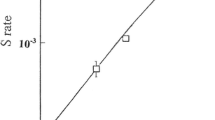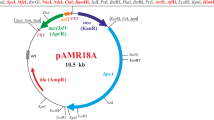Summary
Crossing experiments are performed with the starforming bacteriumPseudomonas echinoides, in order to ivestigate the genetical structure of the cells and the mechanism of the gen transfer. For this purpose mutants are produced mainly by nitrite. They are selectively marked by synthesis blocks and nonselectively by different pigment production. With these mutants reverse crosses and multioint testcrosses are performed. By quantitative evaluation of the crosses it is possible to arrange the sequence and the approximate distance of the gens to a linear chromosome map.
All cells behave statistically equivalent during the genetical exchange. All mutants are sexual compatible. The experiments do not show any sexual polarity.
Similar content being viewed by others
Literature
Ames, B. N., andBarbara Garry: Corrdinative repression of the synthesis of four histidine biosynthetic enzymes by histidine. Proc. nat. Acad. Sci. (Wash.)45, 1453–1461 (1959). Zit. nach Ber. wiss. Biol.152, 276–277 (1960).
Bhaskaran, K.: Genetic recombination inVibrio cholerae. J. gen. Microbiol.19, 71–75 (1958).
—: Recombination of characters between mutant stocks ofVibrio cholerae, strain 162. J. gen. Microbiol.23, 47–54 (1960).
Breed, R. S., E. G. D. Murray andN. R. Smith:Bergey's Manual of determinative bacteriology. Baltimore: Williams and Willkins Company 1957.
Cavalli-Sforza, L. L.: La sessualità nei batteri. Boll. Ist. sieroter. milan.29, 281–289 (1950).
—, andJ. L. Jinks: Studies on the genetic system ofE. coli K 12. J. Genet.54, 87–112 (1956).
—,J. Lederberg andEsther M. Lederberg: An infective factor controlling sex compatibility inBacterium coli. J. gen. Microbiol.8, 89–103 (1953).
Clowes, R. C., andD. Rowley: Some observations on linkage effects in genetic recombination inE. coli K 12. J. gen. Microbiol.11, 250–260 (1954).
Demerec, M., andP. E. Hartman: Complex loci in microorganisms. Ann. Rev. Microbiol.13, 377–406 (1959).
Hartman, P. E., andS. H. Goodgal: Bacterial genetics (with particular reference to genetic transfer). Ann. Rev. Microbiol.13, 465–504 (1959).
Hayes, W.: Recombination inBact. coli K 12: unidirectional transfer of genetic material. Nature (Lond.)169, 118–119 (1952a).
—: Genetic recombination inBact. coli K 12: analysis of the stimulating effect of ultraviolet light. Nature (Lond.)169, 1017–1018 (1952b).
—: The mechanism of genetic recombination inE. coli. Cold Spr. Harb. Symp. quant. Biol.18, 75–93 (1953a).
—: Observations on a transmissible agent determining sexual differentiation inBact. coli. J. gen. Microbiol.8, 72–88 (1953b).
—: Genetics of microorganisms. Brit. med. Bull.18, 1–86 (1962).
—, andR. C. Clowes: Microbial genetics. The tenth Symp. of the Soc. for gen. Microbiol., Cambridge: University Press 1960.
Heumann, W.: Die Sternbildung durchRhizobium. Ber. dtsch. bot. Ges.67, 29–30 (1954).
—: Der Sexualcyclus sternbildender Bakterien. Arch. Mikrobiol.24, 362–395 (1956).
—: Kreuzungsversuche mit sternbildenden Bakterien. Arch. Mikrobiol.36, 244–256 (1960).
—: Versuche zur Rekombination sternbildender Bakterien. Naturwissenschaften47, 330–331 (1960).
—: Die Methodik der Kreuzung sternbildender Bakterien. Biol. Zbl.81, 341–354 (1962).
Heumann, W.: Hemmung der Vitamin B12-Synthese durch Histidin beiPs. echinoides. Naturwissenschaften49, 430 (1962).
Hirota, Y.: The effect of acridine dyes on mating type factors inEscherichia coli. Proc. nat. Acad. Sci. (Wash.)46, 57–64 (1960).
—, andT. Iijima: Acriflavine as an effective agent for eliminating F-factor inEscherichia coli K 12. Nature (Lond.)180, 655–656 (1957).
Holloway, B. W.: Genetic recombination inPseudomonas aeruginosa. J. gen. Microbiol.13, 572–581 (1955).
—: Selffertility inPseudomonas aeruginosa. J. gen. Microbiol.15, 221–224 (1956).
—: Genetic recombination inPseudomonas aeruginosa. Proc. Intern. Congr. Genet. 10th Meeting Montreal, vvl. 2, p. 123. Toronto: University of Toronto Press 1958.
—, andBarbara Fargie: Fertility factors and genetic linkage inPseudomonas aeruginosa. J. Bact.80, 362–368 (1960).
—, andPamela A. Jennings: An infectous fertility factor forPseudomonas aeruginosa. Nature (Lond.)181, 855–856 (1958).
Jacob, F., etE. L. Wollman: Etapes de la recombinaison génétique chezE. coli K 12. C. R. Acad. Sci. (Paris)240, 2566–2568 (1955).
——: Sur les processus de conjugaison et de recombinaison génétique chezE. coli. I. L'induction par conjugaison ou induction zygotique. Ann. Inst. Pasteur91, 486–510 (1956).
——: Les épisomes éléments génétiques ajutés. C. R. Acad. Sci. (Paris)247, 154–156 (1958).
——: Sexuality and the genetics of bacteria. New York and London: Academic Press 1961.
Kaudewitz, F.: Inaktivierende und mutagene Wirkung salpetriger Säure auf Zellen vonEscherichia coli. Z. Naturforsch.14b, 528–537 (1959).
Lederberg, J.: Gene recombination and linked segregations inE. coli. Genetics32, 505–525 (1947).
—L. L. Cavalli andEsther M. Lederberg: Sex compatibility inE. coli. Genetics37, 720–730 (1952).
—Esther M. Lederberg, N. D. Zinder andE. R. Lively: Recombination analysis of bacterial heredity. Cold. Spr. Harb. Symp. quant. Biol.16, 413–441 (1951).
—, andE. L. Tatum: Gene recombination inE. coli. Nature (Lond.)158, 558 (1946a).
——: Novel genotypes in mixed cultures of biochemical mutants of bacteria. Cold. Spr. Harb. Symp. quant. Biol.11, 113–114 (1946b).
—, andN. D. Zinder: Concentration of biochemical mutants of bacteria with penicillin. J. Amer. chem. Soc.70, 4267 (1948).
Marx, Ruth, u.W. Heumann: Über Geißelfeinstrukturen und Fimbrien bei zweiPseudomonas-Stämmen. Arch. Mikrobiol.43, 245–254 (1962).
Newcombe, H. B., andM. H. Nyholm: Anomalous segregations in crosses ofE. coli. Amer. Naturalist84, 457–465 (1950).
Rothfels, K. H.: Gene linearity and negative interference in crosses ofE. coli. Genetics37, 297–311 (1952).
Satyanarayana, T., andA. N. Rhadakrishnan: Biosynthesis of valine and isoleucine in plants. Biochim. biophys. Acta (Amst.)56, 197–199 (1962).
Stapp, C.: Der Pflanzenkrebs und sein ErregerPseudomonas tumefaciens. XI. Cytologische Untersuchungen des bakteriellen Erregers. Zbl. Bakt., II. Abt.105, 1–14 (1942).
—, u.H. Bortels: Der Pflanzenkrebs und sein ErregerPseudomonas tumefaciens. II. Über den Lebenskreislauf vonPs. tumefaciens. Z. Parasitenk.4, 101–125 (1931).
—, u.D. Knösel: Zur Genetik sternbildender Bakterien. Zbl. Bakt., II. Abt.108, 243–259 (1954).
——: Fortgeführte Untersuchungen über den Entwicklungszyklus und die Karyologie sternbildender Bakterien. Zbl. Bakt., II. Abt.109, 416–428 (1956b).
Strassman, M., Jennie Shatton andSidney Weinhouse: Conversion of α-acetolactic acid to the valine precursor α, β-dihydroxyvaleric acid. J. biol. Chem.235, 700–705 (1960).
Tatum, E. L., andJ. Lederberg: Gene recombination in the bacteriumEscherichia coli. J. Bact.53, 673–684 (1947).
Taylor, A. L., andE. A. Adelberg: Linkage analysis with very high frequency males ofEscherichia coli. Genetics45, 1233–1243 (1960).
Umberger, H., Barbara Brown andE. J. Eyring: Isoleucine and valine metabolism inEscherichia coli. IX. Utilization of acetolactate and acetohydroxybutyrate. J. biol. Chem.235, 1425–1432 (1960).
Wagner, R. P., andArloa Bergquist: Nature of the genetic blocks in the isoleucine-valine mutants ofSalmonella. Genetics45, 1375–1386 (1960).
Wollman, E. L., etF. Jacob: Lysogénie et recombinaison génétique chezE. coli K 12. C. R. Acad. Sci. (Paris)239, 455–456 (1954).
——: Sur le mécanisme du transfert de matériel génétique au cours de la recombinaison chezE. coli K 12. C. R. Acad. Sci. (Paris)240, 2449–2451 (1955).
——: Sur les processus de conjugaison et de récombinaison chezE. coli. II. La localisation chromosomique du prophage λ et les conséquences génétiques de l'induction zygotique. Ann. Inst. Pasteur93, 323–339 (1957).
Author information
Authors and Affiliations
Additional information
Mit 1 Textabbildung
Rights and permissions
About this article
Cite this article
Heumann, W. Genetische Untersuchung Sternbildender Bakterien. Zeitschrift für Vererbungslehre 93, 441–452 (1962). https://doi.org/10.1007/BF00888802
Received:
Issue Date:
DOI: https://doi.org/10.1007/BF00888802




